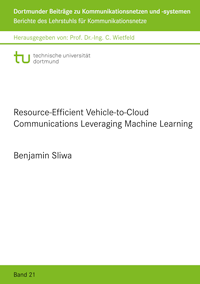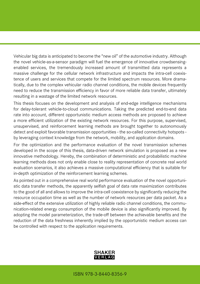
Shop : Details
Shop
Details
49,80 €ISBN 978-3-8440-8356-9Softcover288 pages129 figures428 g21 x 14,8 cmEnglishThesis
December 2021
Benjamin Sliwa
Resource-Efficient Vehicle-to-Cloud Communications Leveraging Machine Learning
Vehicular big data is anticipated to become the "new oil" of the automotive industry. Although the novel vehicle-as-a-sensor paradigm will fuel the emergence of innovative crowdsensing-enabled services, the tremendously increased amount of transmitted data represents a massive challenge for the cellular network infrastructure. More dramatically, the complex vehicular radio propagation environments frequently require to reduce the transmission efficiency in favor of more reliable data transfer, ultimately resulting in a wastage of the limited network resources. This thesis focuses on the development and analysis of novel solution approaches that utilize end-edge intelligence mechanisms at the client devices for vehicle-to-cloud data transfer targeted at delay-tolerant applications. For this purpose, supervised, unsupervised, and reinforcement learning methods are brought together to autonomously detect and exploit favorable transmission opportunities. The results of this thesis show that machine learning-based data rate prediction models are well able to account for the complex interplay of the different logical context domains. As a result, they provide the fundamental information for autonomously learning resource-efficient data transfer policies. As pointed out by a comprehensive real world performance evaluation, the apparently selfish goal of data rate maximization contributes to the good of all and allows to improve the intra-cell coexistence through significantly reducing the number of required network resources per data packet.
Keywords: Machine Learning; Vehicle-to-Cloud; V2X
Dortmunder Beiträge zu Kommunikationsnetzen und -systemen
Edited by Prof. Dr.-Ing. C. Wietfeld, Dortmund
Volume 21
Available online documents for this title
You need Adobe Reader, to view these files. Here you will find a little help and information for downloading the PDF files.
Please note that the online documents cannot be printed or edited.
Please also see further information at: Help and Information.
Please also see further information at: Help and Information.
| Document |  | Document | ||
| Type |  | |||
| Costs |  | 37,35 € | ||
| Action |  | Purchase in obligation and download the file | ||
| Document |  | Table of contents | ||
| Type |  | |||
| Costs |  | free | ||
| Action |  | Download the file | ||
User settings for registered online customers (online documents)
You can change your address details here and access documents you have already ordered.
User
Not logged in
Export of bibliographic data
Shaker Verlag GmbH
Am Langen Graben 15a
52353 Düren
Germany
Am Langen Graben 15a
52353 Düren
Germany
Mon. - Thurs. 8:00 a.m. to 4:00 p.m.
Fri. 8:00 a.m. to 3:00 p.m.
Fri. 8:00 a.m. to 3:00 p.m.
Contact us. We will be happy to help you.



